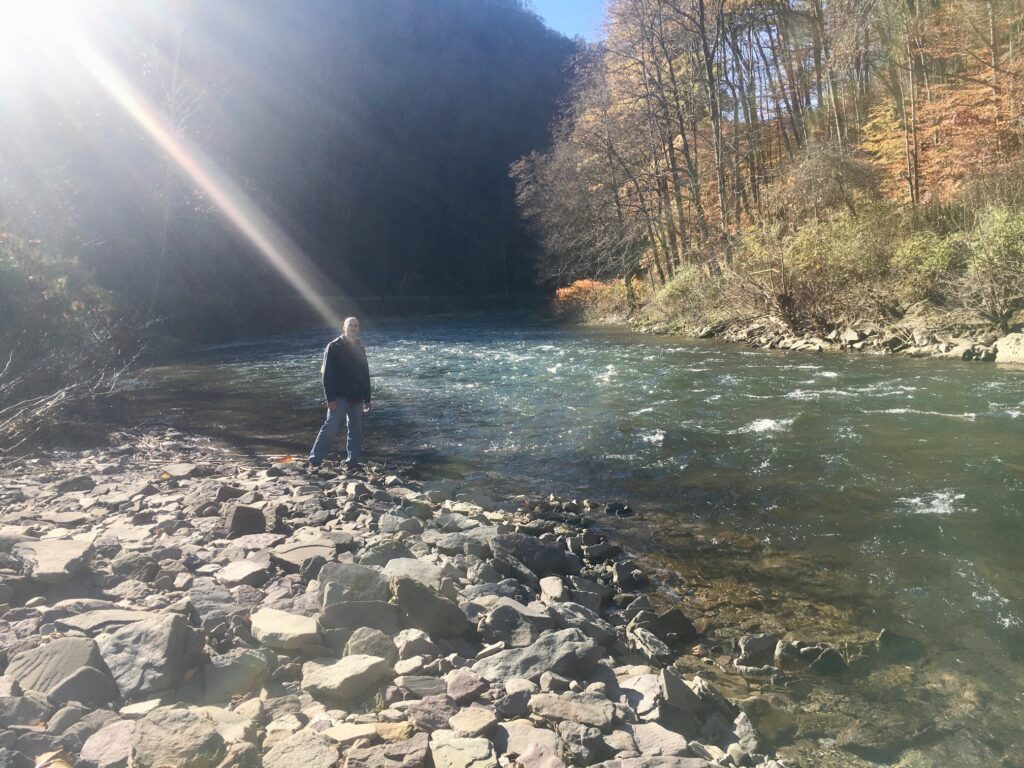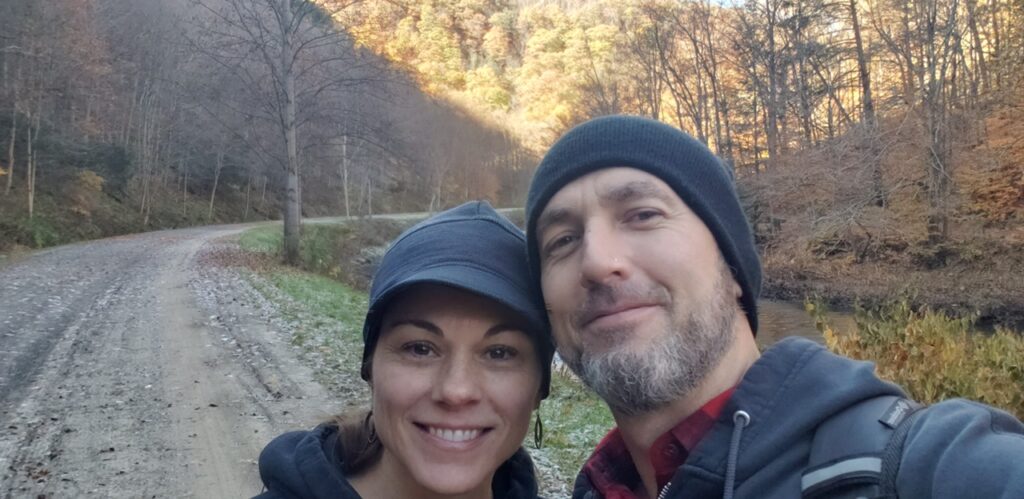
I skipped my first stone last week. Forty-eight years old, and I finally learned how to do it. [Insert joke about old dog.] Others have shown me that particular skill. But he is different, this man I love—the one who taught me. Rather, I am different now, with him. I’m a little easier on myself, and more honest with myself, than I have been for most of my life.
A lot of that is because he’s led by example. For him, honesty is a must—not just the outward kind but the reflective, inward kind, the kind that keeps him striving to learn more about himself and the world, to dig deeper, try harder, relinquish control again and again, practice gratitude, and serve others. Honesty is what saved him and what helps to keep him afloat. Honesty is the first of the 12 Virtues in the Big Book. It is needed for the first of the 12 Steps, which he has learned and lives, and now helps others learn and live.
In the beginning, he told me he would answer any question I had about his past. His past includes chapters that sounded more like a movie than real life. I had a lot of questions. And the more he answered—the WAY he answered—the more I realized that there are different kinds of honesty, and his was a new kind for me. It was clearer and truer, because it was absent of shame or agenda. He had neither. He had done the work already—the work of making sense, making amends, making peace with it all. So he wasn’t asking for or relying on me to do anything with his truth. He wasn’t telling me just enough true things to manipulate my emotions, or his reputation. He wasn’t shortcutting past the most painful parts of his lived experience. This astounded me.
And because he wasn’t doing any of those things, I realized that I had spent my life doing all of them—mostly disclosing slightly vague truths that glossed over things I was ashamed of, or making what I thought were soul-baring confessions that were actually laced with egoic agendas. I don’t think I consciously meant to not be completely honest. But telling the whole truth is so hard, particularly when you’re not even honest with yourself. And I was not, it turns out, often honest with myself.
Thanks to him that began to change, though not easily. I’d gotten so used to listening to a warped inner voice bent on both punishing me and protecting me, that I’ve had to learn how to hone in on what is real: What I really think. How I really feel. What I really want. How things really are. It’s embarrassing how challenging it is for me to identify those things. But I’m slowly getting better at it.
I don’t think he has any idea how much I’ve learned just by observing him, by noticing how good he is at identifying and expressing his feelings. He asks me what I think—about everything—and gives me space to consider before I answer. That space is necessary because I have to figure out whether shame or agenda is attached to the first thing I’m thinking of saying. If so, I know it’s not the Actual Truth, because it’s tainted with my fears and judgments. I don’t always get it right in the moment; I say things I think are real and then realize later they came from the inner voice that lies to me. I do a lot of circling back and clarifying, trying again to get us both to understand me.
He disagrees with me respectfully, and encourages me to dive deeper and say more, not because he wants to challenge my opinion or thought but because he wants to know me more completely.
The craziest bit is that he tells me, without prompting, when he believes he has fallen short—in a day, a moment, or a conversation with someone. And when that happens, he reaches out to make amends if needed. It is part of the code he lives by, that no hurt, resentment or fear is allowed to fester. With him, nothing is left unsaid or misunderstood. Nothing. It is a beautiful and freeing way to live. It is also an exceptionally challenging practice.

That leads me to the stone skipping. I have tried to skip stones before, but only on the sly when others aren’t looking. People have attempted to coach me (“Hold it like this. Flick it like this.”) but when they’ve done so I’ve mostly nodded, watched their stone fly across the water a few times, then kept myself busy searching for a perfect rock to throw when I’m absolutely certain they’re not looking.
So when we come across an oasis of rocks along the creekside trail we’re hiking, he starts skipping stones, and I have the thought I always do when I see someone skipping stones: I wish I could do that. Then that other inner voice chimes in: You can’t. Don’t.
I take a breath. Risking failure has rarely been worth it to me. But now, with him, things are different. I watch him toss another stone; it touches the water seven or eight times before dipping under. He is clearly some type of stone-skipping savant.
I consider what is actually true: I wish I could do that. I can’t, yet. Then I give myself a silent pep talk. Don’t let this go unsaid. Don’t let the fear fester.
“I’ve never skipped a stone,” I say. It is a tiny thing, yet I can feel how proud of myself I am for saying it. Saying my inner desire out loud is something I’ve been working hard on: Matching my outsides to my insides. I’m also proud of saying it because I know what will come next. I know I am about to risk failure in front of the person I desperately, daily want to impress.
“What?! Never?” he asks.
He seems incredulous, and I feel a faltering. He thinks I’m lame and dumb and not coordinated and “I mean I’ve tried, but I’ve never been able to.” YES. Actual Truth shutting up what feels real but isn’t really real. “Lame and dumb” is the lie. The truth is the fear of failure, and admitting to it is the vulnerable territory into which I keep tiptoeing. Following the trail he’s blazed.
He leans down to find another stone. I am crouched nearby, hunting for the perfect rock to keep as a souvenir. He shows me the shape to look for in a good skipping-stone, the right way to hold the rock, how to give it the last-second flick as it leaves my hand.
He throws; it skips; I watch. He picks up another one, throws. It skips all the way down the creek. I’ve never seen anything like it. It must have skipped a dozen times.
I pick up a rock, throw it, kerplunk. I pick up another one, twist my fingers around it the way I think he showed me. I throw, trying to flick. Kerplunk. Again, and again. Kerplunk. Kerplunk.
I notice that I am not feeling terrible about this. This is not feeling like failure, it’s just feeling like a moment. It is feeling like the truth. I am learning that Actual Truth is void of judgment or agenda, which is both a relief and an incentive.
He comes over and shows me again. We do it together, in slow motion. “Flat side down” … “Your thumb here” … “just as it’s letting go, give it a push with this finger.” We release, me right after him. His skips; mine drops.
“Wait,” I say. “I should probably do it with my left hand.” I realize I have been mimicking him, throwing with my right just like him.
“You’re left-handed?!” he says, as if he’s rediscovering something I know he already knows. I smile and pick up another stone, hold it flat side down with my left hand, and try to focus but not overthink. I’m not sure if he’s watching me; I’m not sure if I want him to.
I throw it—and it skips across the water. I don’t know which one of us yells first.
Then I do it again. Because everything takes practice.

